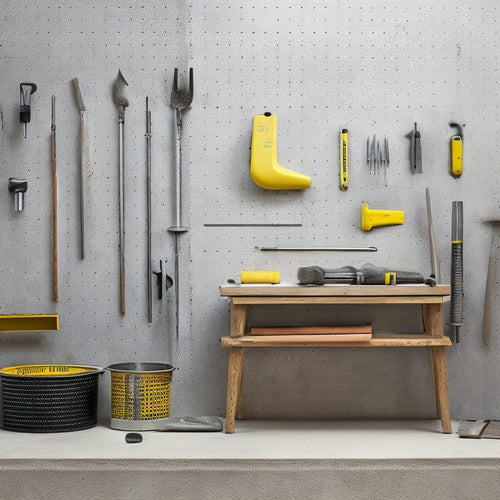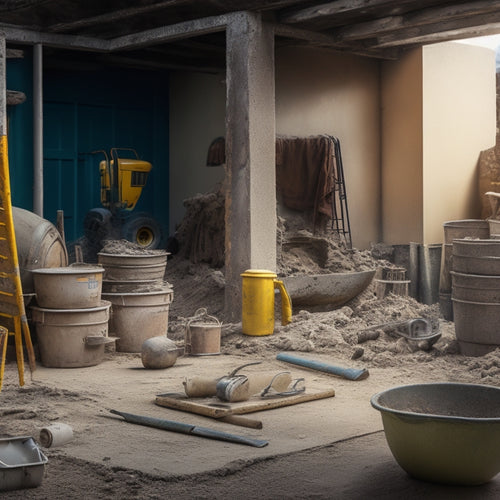
What Tools Need Regular Concrete Finishing Maintenance
Share
You know that tamping tools, edgers, floats, trowels, and finishing blades are essential for a perfectly finished concrete surface, but they need regular maintenance to perform at their best. Your tamping tools require inspection and cleaning to prevent dirt and debris accumulation, while your edgers need frequent sharpening to maintain quality finishes. You should also store your floats properly, clean your trowels daily, and inspect your finishing blades regularly for signs of wear or damage. By staying on top of maintenance, you'll extend the lifespan and enhance the performance of these critical tools - and mastering these habits will take your concrete finishing skills to the next level.
Key Takeaways
• Tamping tools require regular inspection and cleaning to prevent dirt and debris accumulation and extend their lifespan.
• Edgers need frequent sharpening to maintain quality concrete finishes and prevent poor results and increased labor costs.
• Floats should be stored in dry, protected areas, cleaned, and maintained according to their material type to prevent damage.
• Trowels need daily cleaning to prevent concrete residue from hardening and to maintain their balance for smooth, even finishes.
• Finishing blades require regular inspection for signs of wear, damage, or buildup to ensure quality finishes and optimal function.
Tamping Tools Require Regular Care
You need to regularly inspect and clean your tamping tools to prevent dirt and debris from accumulating and affecting their performance. A thorough inspection will help you identify any damage or wear on the tool materials, allowing you to take corrective action before it's too late.
When cleaning your tamping tools, use a soft brush or cloth to remove any loose dirt or debris. For more stubborn stains, you can use a mild detergent and water solution. Avoid using harsh chemicals or abrasive materials that can damage the tool materials.
Proper cleaning and maintenance will also help you master various tamping techniques. By keeping your tools in good condition, you'll be able to achieve a more consistent and even finish.
This, in turn, will give you more control over the final result, allowing you to produce high-quality concrete finishes. Remember, regular maintenance is key to extending the lifespan of your tamping tools and ensuring they continue to perform at their best.
Edgers Need Frequent Sharpening
While maintaining tamping tools is essential, it's equally important to focus on edgers, which require frequent sharpening to prevent dullness from affecting the quality of your concrete finishes.
You'll need to sharpen your edgers regularly, depending on the type of edger you're using and the frequency of use. For instance, manual edgers may need sharpening every few uses, while power edgers might require sharpening after every project.
There are different sharpening techniques you can use, such as using a diamond stone or a file to hone the blade. You can also use a sharpening jig to guarantee a precise angle and prevent damaging the blade.
When sharpening, make sure to follow the manufacturer's instructions and take necessary safety precautions to avoid injuries.
Floats Demand Proper Storage
Proper storage of your floats is essential to maintaining their effectiveness and extending their lifespan.
When not in use, you should store your floats in a dry, protected area to prevent damage from the elements. This is especially important for floats made of wood or other porous materials, as they can absorb moisture and become warped or damaged.
For metal floats, you should clean them thoroughly before storage to prevent rust or corrosion.
Different float types require different storage methods. For example, resin floats should be stored in a cool, dry place, away from direct sunlight.
Bull floats, on the other hand, can be stored in a vertical position to prevent warping.
You should also consider the float materials when storing them. Some floats may require special storage considerations, such as magnesium floats, which should be stored in a well-ventilated area to prevent the buildup of fumes.
Trowels Need Daily Cleaning
At the end of each workday, trowels should be thoroughly cleaned to prevent concrete residue from hardening and affecting their performance.
You know how different trowel types, such as steel, resin, or polyurethane, require specific cleaning methods. Take the time to remove any dried concrete, dirt, or debris from the blade and handle. This daily routine will guarantee your trowel remains in peak condition, allowing you to maintain ideal control over your concrete finishing techniques.
When cleaning your trowel, use a wire brush or scraper to remove stubborn residue. For more delicate trowel types, use a soft-bristled brush and mild detergent. Always rinse your trowel thoroughly and dry it to prevent rust or corrosion.
Regular cleaning will also help prevent the buildup of old concrete, which can affect the trowel's balance and weight distribution. By incorporating daily cleaning into your routine, you'll be able to achieve smooth, even finishes and maintain the quality of your work.
Finishing Blades Require Inspection
Finishing Blades Require Inspection
Regularly inspect your finishing blades for signs of wear, damage, or buildup, as even the slightest imperfection can compromise the quality of your concrete finish. You can't afford to overlook blade wear, as it can lead to uneven finishes, increased labor costs, and even accidents. To maintain peak performance, establish a regular inspection frequency, ideally after every 5-10 uses or when you notice a decline in finish quality.
During inspection, look for signs of wear, such as chipped or dulled edges, rust, or corrosion. Check for buildup, like dried concrete or debris, that can affect blade performance.
Take note of any damage, like bent or warped blades, which may require replacement. Adjust your inspection frequency based on usage and environmental factors, like exposure to harsh weather conditions.
Frequently Asked Questions
Can Old Concrete Finishing Tools Be Restored to Their Original Condition?
You're wondering if you can breathe new life into your old concrete finishing tools. The answer is yes, with the right restoration techniques, you can restore them to their original condition.
How Often Should I Check My Tools for Signs of Wear and Tear?
You should regularly inspect your tools for signs of wear and tear to maximize their lifespan.
Check for wear indicators like rust, corrosion, or excessive wear on moving parts.
It's crucial to catch these issues early to prevent tool failure and extend their lifespan.
Set a routine to inspect your tools every 1-3 months, depending on usage, to make certain they remain in top condition and continue to deliver the best results.
Are There Any Safety Precautions for Handling Sharp Concrete Tools?
When handling sharp concrete tools, you're taking a risk if you're not taking safety precautions seriously. You need to prioritize tool handling safety to avoid accidents.
First, make sure you're wearing the right safety equipment, like gloves, safety glasses, and a dust mask.
Always keep your work area clean and clear of debris to prevent tripping hazards.
Can I Use the Same Cleaning Solution for All Concrete Finishing Tools?
You're wondering if you can use the same cleaning solution for all your concrete finishing tools.
The answer is, it depends on the tool compatibility. Some tools, like trowels, can be cleaned with a mild detergent and water, while others, like power trowels, require a specialized cleaning solution to prevent damage.
Always check the manufacturer's guidelines to verify you're using the right cleaning solution for each tool to maintain their performance and longevity.
Do Concrete Finishing Tools Come With a Manufacturer's Maintenance Guide?
You're wise to wonder if your concrete finishing tools come with a maintenance guide from the manufacturer.
The good news is, most reputable brands provide detailed manufacturer recommendations for tool care.
Don't assume it's a one-size-fits-all approach, though.
Take the time to read and follow the specific guide for your tool to guarantee you're giving it the TLC it needs to perform at its best and extend its lifespan.
Conclusion
You've invested in the right tools for the job, now it's time to maintain them.
Regular concrete finishing maintenance is essential to extend the life of your tools and guarantee quality results.
Did you know that a well-maintained tamping tool can increase its lifespan by up to 50%?
By following these simple tips, you'll be able to get the most out of your tamping tools, edgers, floats, trowels, and finishing blades, and deliver high-quality concrete finishes every time.
Related Posts
-

10 Must-Have Tools for Concrete Repair Organization
You'll need a solid organization system to keep your concrete repair tools and materials within easy reach, protected...
-

Essential Power Tools for DIY Concrete Sculpting
As you begin DIY concrete sculpting, you'll need a strategic selection of power tools to achieve professional-grade r...
-

What Tools Are Needed for Concrete Wall Foundations
You'll need a thorough array of tools and equipment to construct a concrete wall foundation that meets structural int...


